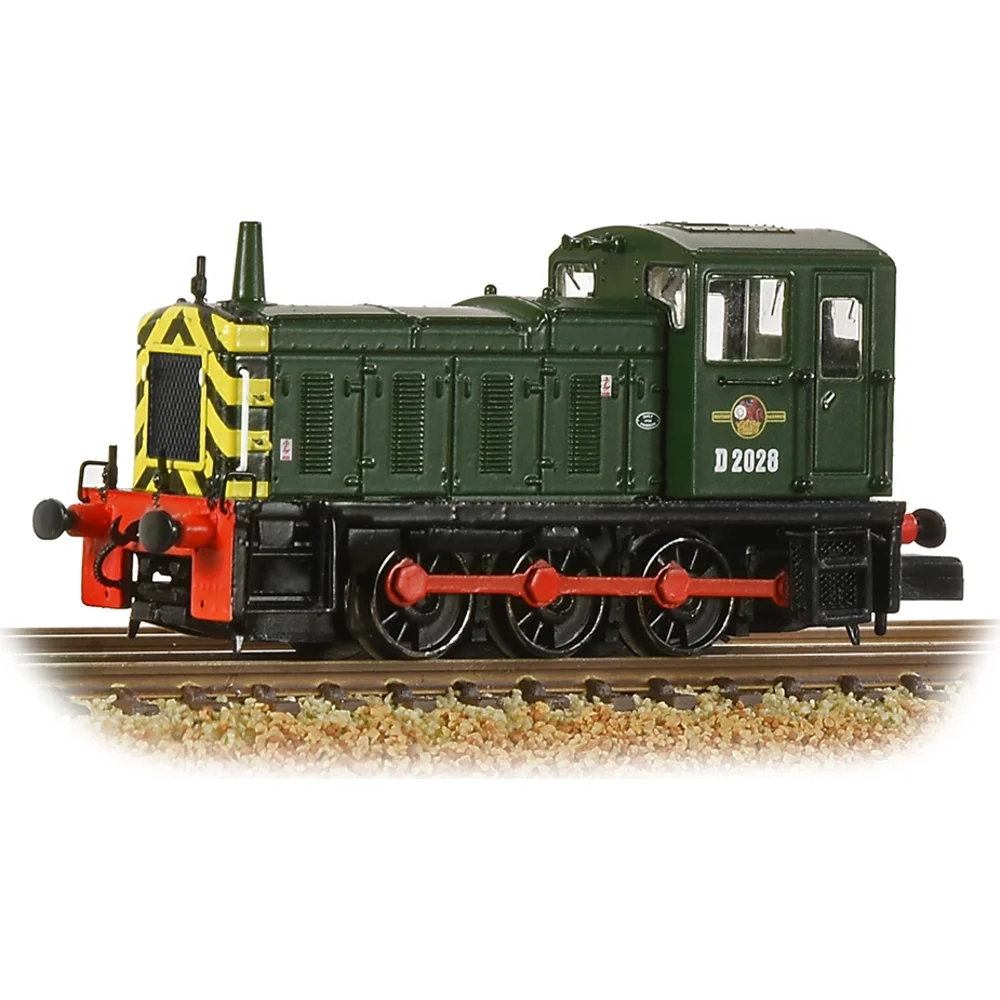Graham Farish 371-061A
British Rail Class 03 D2028 British Railways Green with Late Crest
Tooling
In 2022, Bachmann reintroduced the Graham Farish N Gauge Class 03 diesel-mechanical shunter with a major chassis upgrade. Building on the original 2011 tooling, this revision addressed digital control limitations and improved mechanical performance while retaining the highly detailed bodywork. The Class 03 prototype, built between 1957 and 1962, was BR’s standard small shunter, widely used for light duties where larger locomotives were unsuitable.
Tooling Features
- Construction: Die-cast running plate and bonnet for added weight; plastic bodyshell with fine moulded and separately fitted details.
- Detailing: Separately fitted handrails, lamp brackets, etched step guards, brake pipes, vacuum tanks, guard irons, and bufferbeam detailing. Exhaust variations (flowerpot and conical) supplied to match prototypes. Fully glazed cab with interior detail.
- Couplings: NEM pockets with standard Rapido couplers.
Mechanical & Electrical
- Motor: Powerful coreless motor for smooth, quiet operation.
- Drive: All-wheel drive via jackshaft and coupling rods; all-wheel electrical pickup.
- Weighting: Enhanced by die-cast components for improved traction.
- Lighting: No factory-fitted lighting.
DCC Capability
The 2022 upgrade introduced DCC readiness via a 6-pin micro decoder socket, making conversion straightforward. Bachmann recommends decoder item 36-571 due to space constraints.
Liveries Produced
- BR Green with Late Crest and Wasp Stripes (Era 5)
- BR Blue with Wasp Stripes (Era 7)
- British Industrial Sand White (Era 8)
- Network SouthEast (Isle of Wight) – Kernow Model Rail Centre Exclusive
Reviews & Commentary
The updated Class 03 received positive feedback for its improved running qualities and ease of DCC conversion. Reviewers highlighted the smooth slow-speed performance, ideal for shunting, and praised the retention of fine detailing from the original tooling. The die-cast chassis added welcome weight, enhancing traction. Criticism was minimal, though some noted the absence of factory lighting as a missed opportunity.
Media & Social Media
Video reviews and forum discussions showcased the model’s performance and finish, with particular enthusiasm for weathered examples and the Kernow exclusive NSE livery. Enthusiasts appreciated the upgrade as a practical and aesthetic improvement over the 2011 version.
Interesting Notes
The 2022 tooling maintained the compact 54 mm length, making it one of the smallest powered N gauge locomotives available. The inclusion of etched step guards and optional bufferbeam detailing continued to set a high standard for small shunters in N scale.
Class & Prototype
- Class: British Rail Class 03
- Traction: Diesel
- Transmission: Mechanical
- Built: 1957-1961
- Total Built: 230
The BR Class 03 was British Railways' standard light diesel-mechanical shunter, with 230 built at Doncaster and Swindon Works between 1957-1962. Powered by the legendary Gardner 8L3 engine and featuring distinctive jackshaft drive with coupling rods, these 30-ton locomotives excelled on weight-restricted lines, docks, and industrial sidings where heavier Class 08s couldn't operate. Notable variants included nine cut-down cab examples for the Burry Port & Gwendraeth Valley Railway and two for Isle of Wight tunnel clearance. With 56 preserved (24% survival rate) and the last example working until 2008, the Class 03 remains popular with heritage railways and modellers alike.
No prototype found.
Operator & Livery
- Operator: British Railways
- Livery: Green with Late Crest
British Railways transformed Britain's fragmented rail network into a unified national system following nationalisation on 1st January 1948. Created from the "Big Four" companies under the Transport Act 1947, BR operated most of Great Britain's railways until rebranding as British Rail in 1965, managing over 20,000 route miles and inheriting nearly 20,000 locomotives of diverse designs.
The organisation pioneered standardisation through its revolutionary BR Standard locomotive programme (1951-1960), producing 999 advanced steam engines under Robert Riddles' direction. These included the versatile Britannia Pacifics, mighty 9F freight engines, and mixed-traffic classes that incorporated the best features from all predecessor companies. The 1955 Modernisation Plan accelerated diesel and electric traction development, creating fascinating mixed-traction operations.
Notable achievements included establishing unified locomotive classification systems, introducing distinctive corporate liveries, and managing the complex transition from steam to modern traction. BR's six regional structure preserved operational diversity whilst enabling standardisation of practices, signalling, and rolling stock that had eluded private enterprise for over a century.
The BR era represents steam traction's final flowering alongside emerging diesel technology, creating unparalleled locomotive variety. Today, this heritage remains highly popular with railway enthusiasts through extensive preserved fleets, heritage railway operations, and comprehensive model ranges from manufacturers like Hornby, Bachmann, and Dapol, making BR subjects essential for authentic post-war British railway modelling across all scales.
